Bitche
Bitche (German and Lorraine Franconian : Bitsch) is a commune in the Moselle department of the Grand Est administrative region in north-eastern France. It is the Pays de Bitche's capital city and the seat of the canton of Bitche and the communauté de communes du Pays de Bitche.
Bitche | |
|---|---|
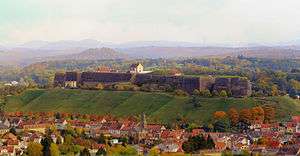 .jpg)    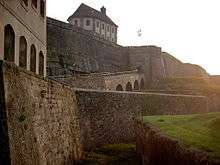 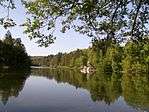  From top left: Citadel; Porte de Strasbourg and Sainte-Catherine Church; Saint-Augustin Chapel; Jardins pour la paix; Citadel's Chapel; Jardins pour la paix with the Sainte-Catherine Church in the background; Citadel viewed from the side; The Hasselfurt pond; Skyline from the citadel | |
 Coat of arms | |
Location of Bitche 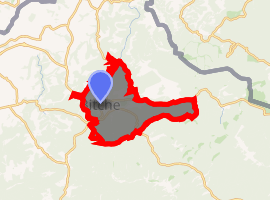
| |
 Bitche 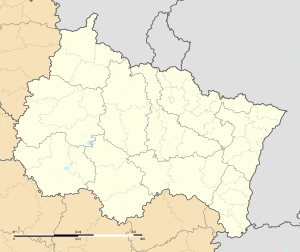 Bitche | |
| Coordinates: 49°03′N 7°26′E | |
| Country | France |
| Region | Grand Est |
| Department | Moselle |
| Arrondissement | Sarreguemines |
| Canton | Bitche |
| Intercommunality | CC du Pays de Bitche |
| Government | |
| • Mayor (2020–2026) | Benoît Kieffer |
| Area 1 | 41.13 km2 (15.88 sq mi) |
| Population (2017-01-01)[1] | 5,098 |
| • Density | 120/km2 (320/sq mi) |
| Time zone | UTC+01:00 (CET) |
| • Summer (DST) | UTC+02:00 (CEST) |
| INSEE/Postal code | 57089 /57230 |
| Elevation | 249–432 m (817–1,417 ft) (avg. 290 m or 950 ft) |
| 1 French Land Register data, which excludes lakes, ponds, glaciers > 1 km2 (0.386 sq mi or 247 acres) and river estuaries. | |
The town belongs to the Northern Vosges Regional Nature Park and is rated 4-flowers at the towns and villages in bloom competition. As of the 2013 France census, the town's population is 5,225. The inhabitants of the commune are known as Bitchois and Bitchoises.
The town is known for its large citadel originating from a castle built at the beginning of the 13th century. The fortress is noted for its resistance during the Franco-Prussian War. Louis-Casimir Teyssier, its commander and chief, held the place for about 8 months with 3,000 men against about 20,000 Prussian and Bavarian soldiers until the French government ordered him to surrender after the ceasefire in 1871. The town became part of Germany after that date until the end of the First World War, when it was given back to France. During the Second World War, it was annexed by the Third German Reich (1940-1944).
Geography
Bitche is located near the German border on the small river Horn, at the foot of the northern slope of the Vosges between Haguenau and Sarreguemines.[2]
History
The town of Bitche, which was formed from the villages of Rohr and Kaltenhausen in the 17th century, derives its name from the old stronghold (mentioned in 1172 as Bytis Castrum) standing on a rock some 250 feet (76 m) above the town. This had long given its name to the countship of Bitsch, which was originally in the possession of the dukes of Lorraine. In 1297 it passed by marriage to Eberhard I of Zweibrücken-Bitsch, whose line became extinct in 1569, when the countship reverted to Lorraine. It passed with that duchy to France in 1766.[2]
After 1766 the town rapidly increased in population. The citadel, which had been constructed by Vauban on the site of the old castle after the capture of Bitche by the French in 1624, had been destroyed when it was restored to Lorraine in 1698. This was restored and strengthened in 1740 into a fortress that proved impregnable up until the 20th century. The attack upon it by the Prussians in 1793 was repulsed.[2]
In 1815 during Napoleon's Hundred Days, Brigadier-General Creutzer was the commandant.[3] Bitche was besieged by General Zollern's Fourth Infantry Division of the Austrian IV Corps, but Creutzer refused to surrender[4] until the general armistice.
Although Bitche was hotly contested by the Germans after the battle of Wörth during the Franco-Prussian War in 1870, it held out until the war's end. A large part of the fortification is built into the red sandstone rock, and was rendered bomb-proof; a supply of water was secured to the garrison by a deep well in the interior.[2] Commander of the fortress of Bitche was Louis-Casimir Teyssier.. After the war, it was given to German Empire as part of Alsace-Lorraine. It was given back to France in 1918.
The town is near the Maginot Line, into which the citadel was integrated. Alsace-Lorraine returned to Germany after the French Campaign in the summer of 1940 and remained under German occupation. The training ground at Bitche was utilized by the German Army to form new divisions, for example the 65th Infantry Division formed at Bitche in July 1942.[5] Bitche was liberated in December 1944 by allied troops but was relinquished in the withdrawal forced by the German counteroffensive. In March 1945 the U.S. 100th Infantry Division broke through the Maginot Line in the Bitche area and liberated the town for good. The attack was a part of Operation Undertone.
After 1945, Bitche became one of the busiest military camps where all parts of the French army manoeuvered. Infantry and cavalry also went to Bitche for experimenting with new weapons during the Cold War. Special training took place against potential bacteriological attacks from the "EAST" side.
Until 1997, military service was compulsory in France. Millions of young soldiers had a few days of training in Bitche.
Population
| Year | Pop. | ±% |
|---|---|---|
| 1793 | 2,480 | — |
| 1800 | 2,339 | −5.7% |
| 1806 | 2,621 | +12.1% |
| 1821 | 2,698 | +2.9% |
| 1836 | 3,077 | +14.0% |
| 1841 | 3,033 | −1.4% |
| 1861 | 2,965 | −2.2% |
| 1866 | 2,740 | −7.6% |
| 1872 | 3,047 | +11.2% |
| 1876 | 2,238 | −26.6% |
| 1881 | 2,908 | +29.9% |
| 1886 | 2,850 | −2.0% |
| 1891 | 2,764 | −3.0% |
| 1896 | 2,854 | +3.3% |
| 1901 | 3,640 | +27.5% |
| 1906 | 4,758 | +30.7% |
| 1911 | 2,864 | −39.8% |
| 1921 | 3,151 | +10.0% |
| 1926 | 3,486 | +10.6% |
| 1931 | 5,552 | +59.3% |
| 1936 | 9,342 | +68.3% |
| 1946 | 3,479 | −62.8% |
| 1954 | 4,401 | +26.5% |
| 1962 | 4,277 | −2.8% |
| 1968 | 5,004 | +17.0% |
| 1975 | 5,055 | +1.0% |
| 1982 | 5,648 | +11.7% |
| 1990 | 5,517 | −2.3% |
| 1999 | 5,752 | +4.3% |
| 2006 | 5,607 | −2.5% |
| 2009 | 5,415 | −3.4% |
International relations
Bitche has been twinned with Lebach, Saarland, Germany since 1979.
The town of Bitche was mentioned in BBC comedy panel game QI, in episode 9 of season 3 (or series "C", as the show refers to the series by letters of the alphabet). Bill Bailey commented on the comical nature of seeing a sign "You are now leaving Bitche".
Gallery
 The city hall in Bitche
The city hall in Bitche- Looking down a street in Bitche
- Overlooking Bitche from the Citadel
 Bitche Citadel Drawbridge
Bitche Citadel Drawbridge Garrison Chapel at the top of Bitche Citadel
Garrison Chapel at the top of Bitche Citadel
See also
Notes
- "Populations légales 2017". INSEE. Retrieved 6 January 2020.
-

- Bombelles et al. 2008, p. 319.
- Siborne 1895, p. 769.
- Welten, Wilhelm "Vom Kugelbaum zur Handgranate: die Gesichte der 65. Infanterie Division"
References
- Bombelles, Marc, marquis de; Grassion, Jean; Durif, Frans; Charon-Bordas, Jeannine (2008), Marquis de Bombelles Journal Tome VII 1808-15, France: Librairie Droz, p. 319
- Siborne, William (1895), "Supplement section", The Waterloo Campaign 1815 (4th ed.), Birmingham, 34 Wheeleys Road, pp. 767–780
Further reading
| Wikimedia Commons has media related to Bitche. |
- Bitche website, retrieved January 2012 Check date values in:
|accessdate=(help) - Bitche (in French), retrieved January 2012 Check date values in:
|accessdate=(help)
